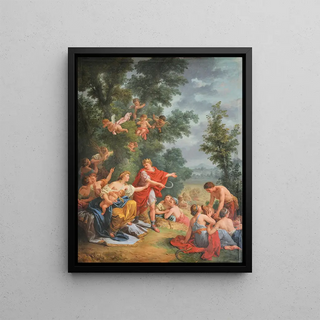Art print | Ceres or Agriculture - Louis-Jean-François Lagrenée


View from behind

Frame (optional)
Louis-Jean-François Lagrenée's Art print "Cérès ou l'Agriculture" is an iconic masterpiece that embodies the spirit of 18th-century France, a period where art and culture intertwined to celebrate the values of nature and humanity. This painting, depicting the Roman goddess Cérès, pays tribute to agriculture and fertility—central themes in Enlightenment thought. As viewers contemplate this work, they are transported to a world where beauty and wisdom converge, offering a profound reflection on the bond between man and the earth. The soft light bathing the scene and the delicate colors create a serene atmosphere, inviting complete immersion into this pastoral universe.
Style and uniqueness of the work
Lagrenée's style is distinguished by its finesse and elegance, characteristic of Rococo. In "Cérès ou l'Agriculture," the artist employs flowing lines and graceful forms to evoke the delicacy of nature. The characters, draped in light fabrics, seem to dance around the goddess, while natural elements such as wheat ears and fruits are rendered with almost tactile precision. The composition is carefully balanced, with each element occupying its place in this celebration of agriculture. Lagrenée manages to create a visual harmony that captures the eye and invites contemplation. Light plays a crucial role in this piece, highlighting details and casting shadows that add depth to the scene. This attention to detail and pursuit of beauty make this painting a perfect example of the art of its time.
The artist and his influence
Louis-Jean-François Lagrenée, painter and decorator, is a significant figure of the 18th century, whose work reflects the aesthetic and philosophical concerns of his era. Trained at the Royal Academy of Painting and Sculpture, he follows in the footsteps of the great masters of his time. His work, which combines tradition and innovation, influences many contemporary and future artists. Lagrenée does not limit himself to

Matte finish

View from behind

Frame (optional)
Louis-Jean-François Lagrenée's Art print "Cérès ou l'Agriculture" is an iconic masterpiece that embodies the spirit of 18th-century France, a period where art and culture intertwined to celebrate the values of nature and humanity. This painting, depicting the Roman goddess Cérès, pays tribute to agriculture and fertility—central themes in Enlightenment thought. As viewers contemplate this work, they are transported to a world where beauty and wisdom converge, offering a profound reflection on the bond between man and the earth. The soft light bathing the scene and the delicate colors create a serene atmosphere, inviting complete immersion into this pastoral universe.
Style and uniqueness of the work
Lagrenée's style is distinguished by its finesse and elegance, characteristic of Rococo. In "Cérès ou l'Agriculture," the artist employs flowing lines and graceful forms to evoke the delicacy of nature. The characters, draped in light fabrics, seem to dance around the goddess, while natural elements such as wheat ears and fruits are rendered with almost tactile precision. The composition is carefully balanced, with each element occupying its place in this celebration of agriculture. Lagrenée manages to create a visual harmony that captures the eye and invites contemplation. Light plays a crucial role in this piece, highlighting details and casting shadows that add depth to the scene. This attention to detail and pursuit of beauty make this painting a perfect example of the art of its time.
The artist and his influence
Louis-Jean-François Lagrenée, painter and decorator, is a significant figure of the 18th century, whose work reflects the aesthetic and philosophical concerns of his era. Trained at the Royal Academy of Painting and Sculpture, he follows in the footsteps of the great masters of his time. His work, which combines tradition and innovation, influences many contemporary and future artists. Lagrenée does not limit himself to






